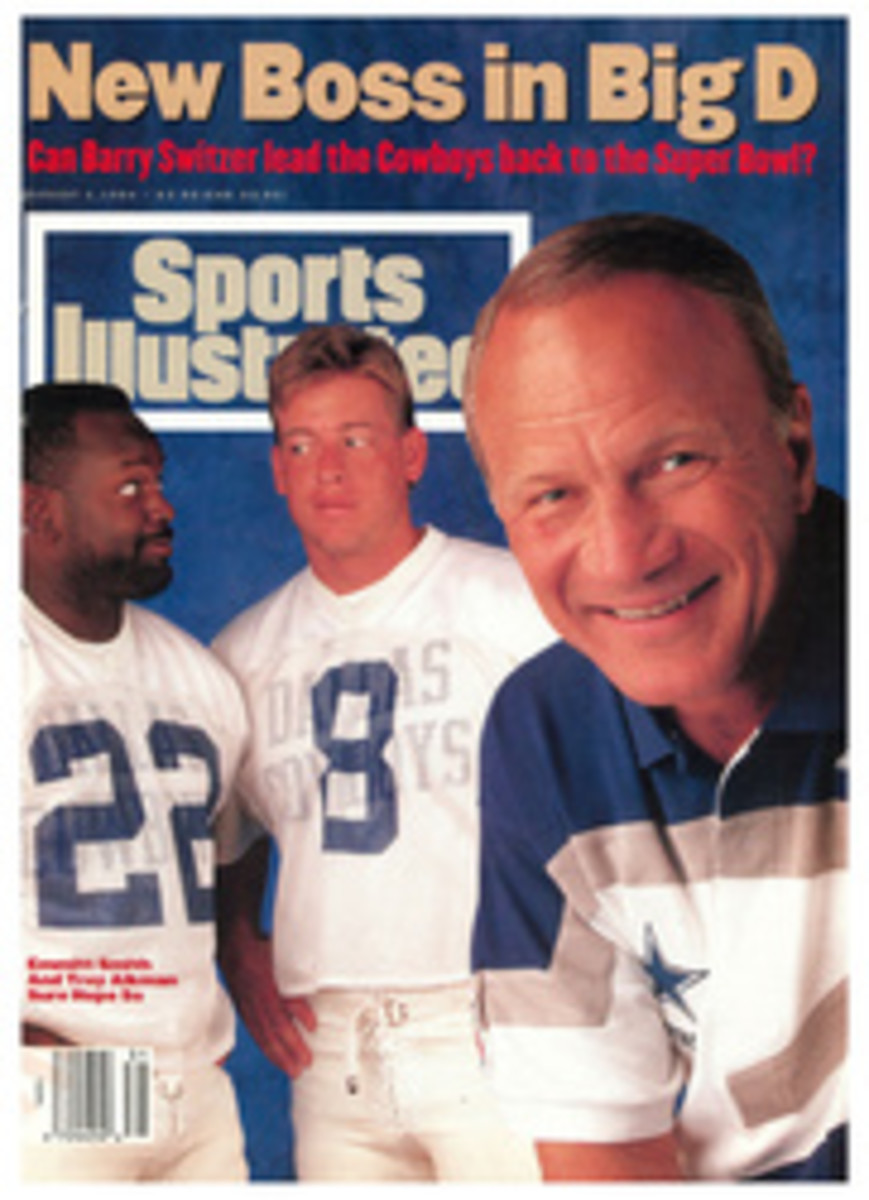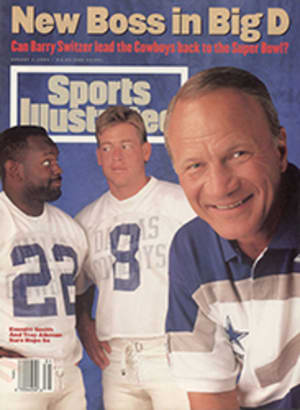
In the Strike Zone
Major league baseball owners would be the Washington Generals of labor negotiations if only their winning percentage were a little better. While they talk a good game of solidarity at the beginning of each confrontation with the players' union, their commitment inevitably turns out to be as embarrassingly brief as Bill Clinton's running shorts.
"But history doesn't always repeat itself," says Richard Ravitch, the 61-year-old professional trouble-shooter who is serving for the first time as the owners' chief negotiator. "This time we're ready."
This time the owners are ready to prove how tough they are. They are so dedicated to obtaining a salary cap that they are pushing the players out on strike, deepening a conflict that is as painfully simple as two children seeing which of them can hold their breath the longest.
The strategy of both sides is not so much to negotiate—Ravitch conceded last week that "serious negotiations" have yet to take place—as it is simply to outlast the enemy. That means the owners, if their commitment is indeed rock solid this time, are willing to see the World Series wiped out. That stands as a real possibility, given the entrenchment in each camp.
The players have not the slightest interest in a cap, and who can blame them? It would hold down player salaries, restrict the movement of free agents and render salary arbitration unworkable. Therefore the players were planning to announce a strike date by the end of this week. They will walk out, according to one source, sometime between Aug. 8 and Aug. 20, barring anything short of a deus ex machina. In fact, a prolonged strike appears so probable that games have begun to take on an end-of-season urgency, with an eye to the possibility that the remainder of the regular season will be wiped out but the postseason will be salvaged.
The owners could remove the need for a player strike at any time by promising not to exercise their right under labor law to impose unilaterally a contract settlement—i.e., a cap—after the scheduled end to the postseason. (A strike would be a preemptive step by the players to thwart such a unilateral action.) Such a promise by the owners would amount to a logical laying down of weapons while the season and the talks continue. That olive branch, however, would most likely leave the owners with at least another year of the current economic system, a notion, so repugnant to many of them that they are willing to suffer huge losses now to avoid it.
"There's been too much of the Scarlett O'Hara philosophy in this game: 'I'll think about it tomorrow,' " says Bud Selig, baseball's quasi-commissioner and the owner of the Milwaukee Brewers, the sort of small-market team that stands to benefit more from the cap than a well-heeled, large-market franchise like the Atlanta Braves. "Well, tomorrow is here."
In the event of a long strike, the losses for the game would go beyond money. They could include the end of the record-challenging work of players such as Ken Griffey, Frank Thomas and Matt Williams, who are chasing Roger Maris's single-season home run mark, and Tony Gwynn, who is bidding to become the first .400 hitter since 1941; a halt to the start-up momentum of The Baseball Network, the owners' quirky new television-marketing venture; and a setback in the public's acceptance of the newly expanded divisional play, which was designed to take the pennant race to more cities. Selig will have an especially hard time convincing the title-starved fans in Cleveland, Montreal and Texas that it is worth kissing off the postseason. The owners wanted to get September back from football, but here they are ready to forfeit the autumn entirely.
Yes, once again the owners are busy running around chirping that the sky is falling—but they really mean it this time—a warning the players won't believe unless a chunk whacks them on the head. Donald Fehr, executive director of the players' union, has suggested the owners support the weak franchises by sharing revenues among themselves without asking the players to be the underwriters.
"If the owners persist in their thinking that they want an artificially controlled mechanism to drive down salaries and destroy free agency," Fehr says, "the players have very few options left. This is not the sort of thing that keeps you up at night thinking about your options. They are systematically leaving the players with one option."
The two sides were scheduled to meet Wednesday, with no common ground apparent. The owners, for instance, recently released charts that suggest a gap in payrolls—from a low of $15.5 million for the San Diego Padres to a high of $52.1 million for the Braves—is "ruining" baseball's competitive balance. The players countered with their own bar graphs illustrating that such payroll gaps have been common since at least 1983 and that competitive balance has never been better. In the past 15 years, 23 of the 28 major league clubs have reached the postseason.
It was as if two doctors held the same X-ray up to the light, with one of them saying the patient required immediate surgery and the other declaring the patient perfectly fit. "I can't bring him around," Ravitch says of Fehr. "Only the players will bring him around."
The futility of the situation is exacerbated by a prickly relationship between the two principal negotiators. In one of their first meetings, Ravitch laid out to Fehr his preferred approach to negotiations: He likes to develop a personal bond with his opposite number to facilitate a deal through backroom bargaining. Fehr was jolted by the idea. Battle-hardened and adversarial after 17 years of negotiating for the players, he wanted no such coziness, and he would not think of excluding players from the front line. The personal conflict has heightened since. "It's a problem," admits one insider to the negotiations. "It's getting worse."
To further complicate matters, these talks are not about finding room for compromise on such issues as pensions (as was the case in 1972), free agency ('76), free-agent compensation ('81) or salary arbitration ('90). This time it is a yes-or-no issue: whether or not to adopt a system that would fix costs for owners. The players have come down resolutely on the no side.
How long will that stalemate be allowed to go on before Selig and other owners join Ravitch at the bargaining table, especially if the Ravitch-Fehr conflict worsens? The union may be more willing to listen to club executives with whom they have a cordial working history, such as Paul Beeston of the Toronto Blue Jays, John Ellis of the Seattle Mariners and John Harrington of the Boston Red Sox.
Oddly, the owners are betting the same development that has traditionally favored the players—that the other side will split when a substantial portion of its membership begins to feel the financial consequences—will work to their advantage this time. During the 50-day strike of 1981, the average loss per player was $1,079 a day, based on an average salary of $185,651. This year, with an average salary of $1.2 million, the average loss per player would be $6,977 a day.
The players have about $175 million in licensing money stockpiled as a strike fund, but that will evaporate quickly. For example, if that fund was disbursed at the rate of $6,977 per player each day, it would last 31 days. That means the players would soon be left to their own resources, which raises the intriguing question: Because the players now make so much money, are they better insulated to withstand a lengthy strike or are they more likely to give in because so much more money is at stake?
"That's a good question," says Kansas City Royal pitcher David Cone. "The union has cautioned us for some time to prepare for something like this, and the licensing money will help, so I don't think players are going to have trouble paying their mortgages."
If that's true, then October, with the emotional and financial wealth of postseason play, looms as the most likely breaking point—with the owners more apt to crack at that time than the players. By then most of the players are typically home, their seasons finished, and would not be getting paid anyway. For the owners, the postseason means 75% of their television income. The pressure to salvage that money may be enormous after weeks of lost gate receipts without the cushion of the $50 million in strike insurance that emboldened management in 1981; this year the owners have none.
That prospect did not stop Jerry Reinsdorf, the hawkish owner of the Chicago White Sox, from recently laying out a scenario in which the game would be shut down until 1996. "I don't think it was a prediction," Ravitch says, "as much as a statement that the owners aren't going to give up so easily. I remain optimistic. The owners and players are not going to preside over the ruination of the game."
Well, that's a relief.
ILLUSTRATION
BRIAN AJHAR
The multimillion-dollar question: Do the owners have the unified strength to put a cap in place?
ILLUSTRATION
BRIAN AJHAR
Neither union leader Fehr nor the owners' Ravitch seems inclined to breathe life into the negotiations.

